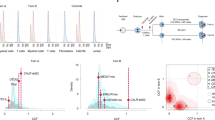Summary:
We report here a monosomy 7 transformation of donor cells following matched-unrelated, same sex, allogeneic bone marrow transplantation in a patient with severe congenital aplastic anemia. A PCR technique was employed to amplify microsatellite markers on chromosome 7 to confirm donor/recipient identity. We found that the transformation of monosomy 7 occurred in previously genetically normal donor cells. This study suggests that the microenvironment of the bone marrow of our patient with severe congenital aplastic anemia may have played a critical role in the development of monosomy 7 of normal donor cells and we conclude that chromosomal microsatellite marker analysis can be a valuable tool for precise donor/recipient differentiation in engraftment monitoring.
This is a preview of subscription content, access via your institution
Access options
Subscribe to this journal
Receive 12 print issues and online access
$259.00 per year
only $21.58 per issue
Buy this article
- Purchase on Springer Link
- Instant access to full article PDF
Prices may be subject to local taxes which are calculated during checkout

Similar content being viewed by others
References
Witherspoon RP, Deeg HJ, Storb R . Secondary malignancies after marrow transplantation for leukemia or aplastic anemia. Transplant Sci 1994; 4: 33–41.
Lawler SD, Baker MC, Harris H et al. Cytogenetic studies on recipients of allogeneic bone marrow using the sex chromosomes as markers of cellular origin. Br J Haematol 1984; 56: 431–443.
Zaccaria A, Alimena G, Baccarani M et al. Cytogenetic analyses in 89 patients with secondary hematologic disorders – results of a cooperative study. Cancer Genet Cytogenet 1987; 26: 65–74.
Boyd CN, Ramberg RC, Thomas ED . The incidence of recurrence of leukemia in donor cells after allogeneic bone marrow transplantation. Leuk Res 1982; 6: 833–837.
Bayever E, Ladisch S, Phillippart M et al. Bone-marrow transplantation for metachromatic leucodystrophy. Lancet 1985; 2: 471–473.
Stein J, Zimmerman PA, Kochera M et al. Origin of leukemic relapse after bone marrow transplantation: comparison of cytogenetic and molecular analyses. Blood 1989; 73: 2033–2040.
Goh K, Klemperer MR . In vivo leukemic transformation: cytogenetic evidence of in vivo leukemic transformation of engrafted marrow cells. Am J Hematol 1977; 2: 283–290.
Scharf SJ, Smith AG, Hansen JA et al. Quantitative determination of bone marrow transplant engraftment using fluorescent polymerase chain reaction primers for human identity markers. Blood 1995; 85: 1954–1963.
Takahashi R, Shimazaki C, Inaba T et al. Donor cell-derived acute myeloid leukemia developed shortly after allogeneic bone marrow transplantation for MDS overt leukemia. Rinsho Ketsueki 2002; 43: 963–965.
Cooley LD, Sears DA, Udden MM et al. Donor cell leukemia: report of a case occurring 11 years after allogeneic bone marrow transplantation and review of the literature. Am J Hematol 2000; 63: 46–53.
McCann SR, Lawler M, Gardener N et al. Donor leukemia following allogeneic bone marrow transplantation. Leukemia 1994; 8: S133–S135.
Lawler M, Humphries P, McCann SR . Evaluation of mixed chimerism by in vitro amplification of dinucleotide repeat sequences using the polymerase chain reaction. Blood 1991; 77: 2504–2514.
Browne PV, Lawler M, Humphries P et al. Donor-cell leukemia after bone marrow transplantation for severe aplastic anemia. N Engl J Med 1991; 325: 710–713.
Bayever E, Haines K, Duprey S et al. Protection of uninfected human bone marrow cells in long-term culture from G418 toxicity after retroviral-mediated transfer of the NEOr gene. Exp Cell Res 1988; 179: 168–180.
Santucci MA, Trabetti E, Martinelli G et al. Host origin of bone marrow fibroblasts following allogeneic bone marrow transplantation for chronic myeloid leukemia. Bone Marrow Transplant 1992; 10: 255–259.
Lawler M . Leukaemogenesis, gene interplay, and the role of the haemopoietic environment. Radiat Oncol Investig 1997; 5: 154–157.
McCann SR, Lawler M, Bacigalupo A . Recurrence of Philadelphia chromosome-positive leukemia in donor cells after bone marrow transplantation for chronic granulocytic leukemia. Leuk Lymphoma 1993; 10: 419–425.
Hashino S, Imamura M, Tanaka J et al. Transformation of severe aplastic anemia in acute myeloblastic leukemia with monosomy 7. Ann Hematol 1996; 72: 337–339.
Author information
Authors and Affiliations
Corresponding author
Rights and permissions
About this article
Cite this article
Lang, Z., Dinndorf, P., Ladisch, S. et al. Chromosomal transformation in donor cells following allogeneic bone marrow transplantation. Bone Marrow Transplant 33, 1253–1256 (2004). https://doi.org/10.1038/sj.bmt.1704450
Received:
Accepted:
Published:
Issue Date:
DOI: https://doi.org/10.1038/sj.bmt.1704450
Keywords
This article is cited by
-
Genetics of donor cell leukemia in acute myelogenous leukemia and myelodysplastic syndrome
Bone Marrow Transplantation (2021)
-
Donor-derived constitutional chromosomal abnormalities after allogeneic hematopoietic cell transplantation: a single-center experience and a review of the literature
Bone Marrow Transplantation (2015)
-
Donor cell-derived leukemia after cord blood transplantation and a review of the literature: differences between cord blood and BM as the transplant source
Bone Marrow Transplantation (2014)
-
Donor-derived isolated del(20q) after hematopoietic stem cell transplantation: report of two cases and review of the literature
Journal of Hematopathology (2013)
-
Genetic differences by platelet-specific antigens used for monitoring allomyelotransplant engraftment
Bulletin of Experimental Biology and Medicine (2006)



